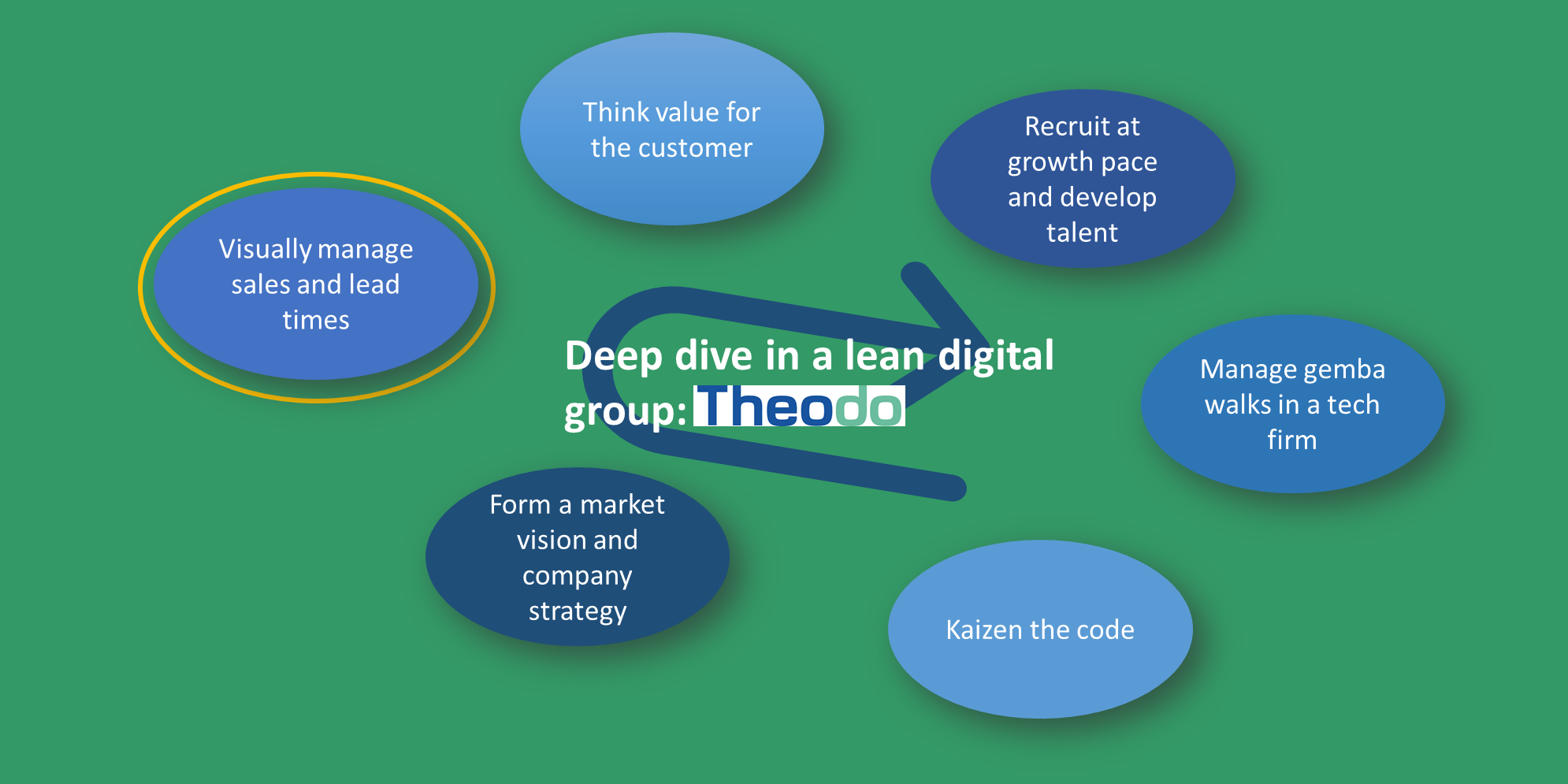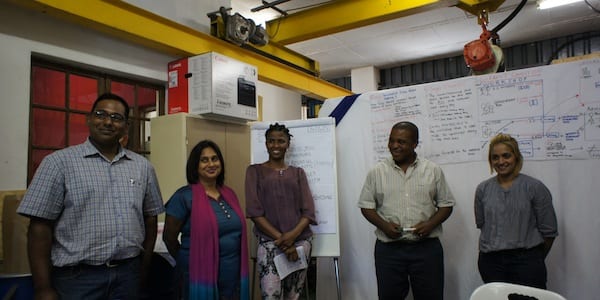
Deep dive in a lean digital company #1
NOTES FROM THE GEMBA – The author visits the office of Theodo France and learns how the lean digital company is leveraging lean thinking and practice to support its ongoing growth – even through the pandemic.
Words: Catherine Chabiron, lean author and member of Institut Lean France.
Today I am meeting Caroline Sauvegrain, Chief of Operations at Theodo France. Caroline co-manages the company with Julien, the CEO, and Maxime, the CTO. Theodo France develops web or mobile apps and has steadily grown since its creation some 12 years ago.
In 2020, the Theodo teams developed the application that supports the French government’s loan backings to companies severely affected by Covid-19. They built it in five days! The App had to be stable and intuitive: in the 24 hours following its release, Bpifrance (a public investment bank) recorded 1,000 visitors per minute and received loan requests of almost €1 billion.
Caroline is just back from Theodo’s annual meeting and feels elated. She tells me: “Our 2020 growth was close to 25%, despite Covid-19. It was far above our own forecast.”
It is a common idea that most start-ups, even those that survive their first 10 years, will fail sooner or later. Theodo France is in its 13th year, and there is no doubt that growing from an idea the company’s founders conceived in a small office to a successful, 130-people organization is no easy road. So, what’s the secret ingredient in Theodo’s recipe for success?

GROWING THE CUSTOMER BASE WITH KANBAN
Caroline gives me a bit more background information. “You should know that 2019 was not a good year for us. Instead of the usual two-digit growth, we plateaued for the first time in years. I felt bad about it, as Sales and Customer satisfaction were within my area of responsibility,” she says.
Caroline moved up the ladder very fast. She was recruited straight out of school in 2015 and promoted to Sales Director in 2017 and to COO in 2019. This quick advancement gave her very few years to learn her trade and experiment with her management approach to understand what works and what doesn’t.
“I thought I could just apply what had worked for me as an individual performer: give people challenging objectives, support them if needed, and count on their willingness to unleash their talent,” she explains.
In her apps-developing world, Caroline focused on moving tickets through a process, be it on Trello or any other task-sharing platform. The team relied on checklists to ensure nothing was amiss, Caroline pointed out the objectives to be achieved and… she was usually disappointed with the result.
She also introduced visual management and a system of red bins, but the customer somewhat disappeared from the process. “It turned out that our process, very early on, was deselecting deals that people believed Theodo was unable or unwilling to take on. Sales was unwillingly becoming a sort of selection process,” Caroline admits. “On the other hand, as I analyzed some of our best deals, I found that people in those instances had not necessarily followed the standard process.”
This setback food for thought. Caroline started reading books on lean management and decided to discuss the issue with her colleagues. “I thought my management approach was to give the mission and offer support. But I learned that people are not looking for superheroes they can blindly follow. Rather, they follow leaders who take a sincere interest in them, their problems and the decisions they have to make.”
This opened Caroline’s eyes. As a result, she developed a new system for Sales, based on kanban cards.

“Each column represents a salesperson, and the different leads are displayed as one kanban for each customer request,” Caroline explains. “We track the lead-time from the moment the request comes in and try to make sure that all customers are served, no matter the size of their request. Just like in ‘ ‘sell one, make one’, we are not supposed to move on until we have managed to lock the deal”.
As I look at a real-life example of the ongoing sales kanban board with Caroline, I can see a huge variation between the underlying requests – from €5k to €2 million). The ageing leads can be easily spotted (some have been hanging there for three months).
I tell Caroline this looks very much like a launcher in a production cell, with kanban cards in the “red” indicating that the production cell is in difficulty.

What they had done before was more like the agile kanban approach we see here and there, where tickets (kanban cards) are shown moving along the flow:

If we come back to the original intent behind the kanban, withdrawal Kanban cards are clear picking signals indicating the need to go and withdraw either components for replenishment on the production line or finished goods to be sent out. But, in an office or digital environment, we are mainly talking about production kanban cards, signalling that production needs to be launched. Moving those cards along the flow, as in agile kanban, somewhat blurs the original intent, which is to assign a given and specific production cell a clear task to do.
Caroline sees plenty of advantages in this new approach:
- She and the teams no longer focus on the “moving forward” at the expense of killing deals that are deemed too difficult to achieve.
- The kanban cards clearly show the imbalance of work between the different production cells (today, each salesperson picks up the leads they are interested in and works on them in parallel). They also highlight the cells that are left with nothing to do.
- The cards demonstrate the vast diversity of customers and customer requests, a real opportunity to enlarge Theodo’s customer base and no longer depend on a few key customers.
The new approach unlocked the teams’ potential. “I was no longer wondering whether they had ticked off such and such point in the process checklist. Instead, I started asking why the lead would not come through, and what could be done to serve that customer,” Caroline says. Team members began to look at customers as real people with their own problems, big or small. They started to investigate new solutions that would better fit small budgets, such as no-code or low-code tools, instead of developing the code from scratch.
One of the most common effects of “big company disease” is that the process always wins over the customer’s individual needs. If you have ever asked for support from an IT hotline, you know what I am talking about. Following the process means that you will be asked to fight with robots before you are allowed to speak with a real human. It seems as though robots are there to prevent you from disturbing customer service representatives. When you are finally allowed in, you have to undergo the check of your contract, your serial number or your licence. Only then does someone begin to listen to you and let you state your problem. But if that problem doesn’t fall within the pre-defined categories of known issues, you will be asked to call someone else and start all over.
What Theodo France has clearly done is choosing customers over processes, which proved to be a great move considering the 25% growth achieved in the middle of a pandemic (when the French GDP is at -8%).
Caroline says: “We lost two big customers in 2020 because of the Covid-19 crisis, and it’s unlikely they will be back any time soon. But all the smaller customers we learned to serve from 2019 onwards, and some bigger ones too, have largely made up for the loss”.
“GOOD THINKING, GOOD PRODUCTS” AND REMOTE WORKING
The new approach brought an array of new solutions but, as ideas cropped up, some were not always perfectly mastered. With growth came quality issues, which led to reworks and delays. “Growth gave us some good problems,” Caroline tells me, smiling.
She takes me on a tour of Theodo’s open-space office and shows me walls covered with open discussions on the technologies that need mastering. There are “traces” of obeyas used to discuss app designs, once the deal is locked, with concept papers, together with the main challenges and decisions the team needs to address in terms of tools, architecture or code. There is plenty of thinking, sharing and learning here.
With the “new normal” created by the Covid-19 pandemic (during parts of the two lockdowns, nearly 100% of the team had to work from home), I ask Caroline how working from home impacted this “good thinking, good products” activity – to frame it as Toyota does. She tells me that, within 24 hours, they had completely transferred their obeyas to a digital platform. With just a few clicks, she shows me the portfolio of projects they designed and that is displayed both in the open space and on the company’s intranet.

As you double-click on any of the lines – some showing a “delayed” status – you enter the digital obeya of the project. Obeyas are key in the design stage, as they contribute to sharing customer expectations within the team. Things like “simple, but precise and detailed” or “a quick solution, free of bugs”. They share the emotion and value the product is expected to provide, rather than detailed specifications.
But this does not mean that technical options will not be thoroughly discussed. Experimenting ideas and making decisions on the technical challenges a project entails is a key step of the design stage (one of the reasons we suffer from reworks is that we always underestimate the time we need to spend on the Plan phase of a PDCA cycle). Beyond the design phase, the obeyas will continue to monitor success on both the product and customer value, on-time delivery, technical challenges, and customer satisfaction.
When I ask Caroline what she would recommend others who need to prepare for a leadership role, she takes a moment to think about her answer. She then confirms that you need to work on your emotions and energy levels, but also develop new muscles – like structured thinking via A3s or learning to see the company in its entirety, as an entity challenged by external threats and that can only achieve sustainability through the development of capabilities. “Capability development provides us with more options and solutions, and increases speed and value for the customers,” she says.
THE AUTHOR

Read more


FEATURE - Norman Faull, Director of Lean Institute Africa, talks about a supplier development project the institute took part in, and shares a few of the results achieved.


FEATURE - Using 5S thinking beyond tools, the article explores how mental clutter, assumptions, and habits create waste—and how structured problem-solving restores clarity.


NOTES FROM THE GEMBA – At GHU Paris, leadership pairs strategy with gemba visits, 5C problem-solving, and cross-functional learning to create a resilient, people-centered improvement culture in psychiatric care.


CASE STUDY – The reimbursement department of the largest independent insurance company in Brazil has brought together lean and digitalization to improve its service to customers.

